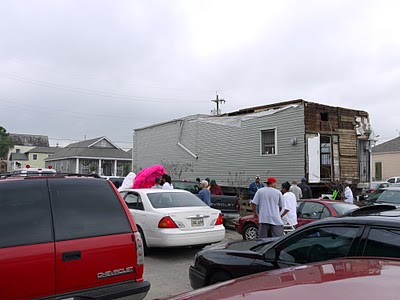
Photo courtesy of insidethefootprint.blogspot.com
By Karen Gadbois, The Lens opinion writer |
It’s no longer just those fussbudget New Orleans preservationists who are concerned. A federal agency has weighed in on the treatment of old houses being moved to make way for the giant LSU/VA medical complex.
“It has come to the attention of the Advisory Council on Historic Preservation (ACHP) that a number of historically significant homes moved from locations impacted by the New Orleans Medical Center Project have been placed in new locations in the city with little or no effort to ensure their protection after relocation,” writes Reid Nelson, the agency’s director, in a letter dated Aug. 4.
Nelson goes on to commend the city for making an effort to save houses once targeted for demolition. “Nevertheless,” he writes, “we are concerned that the relocation plan has not been well-defined, managed effectively by contractors, or sufficiently described for the benefit of residents of affected neighborhoods.”
When the decision to move the houses was announced in July 2010, the Landrieu administration declared it a win/win – a win for preservation as well as for proponents of the hospital, eager to clear the giant footprint and start construction.
But The Lens and our partners at Fox8 TV put together a couple of reports declaring the victory pyrrhic at best. The reports found that the old and delicate houses appeared to have been grossly mishandled. Roofs, trim and whole floors had been lopped off to move the structures past wiring and underpasses. Houses had been plopped down in neighborhoods that had no input in the process.
Unsealed against the elements for months, they stood in lots strewn with garbage or rank with standing water – a breeding ground for mosquitoes as well as drug dealers and associated criminals looking for a lair.
Builders of Hope, the non-profit hired to move and prepare the houses for renovation, blamed the delay on funding issues that had to be worked out with the city. With the payment issue cleared up, Builders of Hope and the city claim all the houses will have roofs by the end of September.
Days after The Lens/ Fox 8 probe was made public on Aug. 2, Nelson fired off his letter to Mayor Mitch Landrieu as well as to Veterans Administration construction honcho Robert L. Neary and John Ketchum, FEMA’s preservation officer.
Identified on its website as “the only entity with legal responsibility to encourage federal agencies to factor historic preservation into federal project requirements,” Nelson’s organization requested information in seven areas of concern, ranging from sources of financing to provisions for public participation in the relocation process.
Asked by The Lens for the city’s response, mayoral spokesman Ryan Berni initially denied receiving the letter.
Bruce Milhans, spokesman for the Advisory Council, found that a little hard to believe. In addition to a copy sent on paper through the U.S. mail, on Aug. 5, the letter was sent by email to Landrieu as well as to Brenda Breaux, a deputy city attorney, and to Scott Hutcheson, the mayor’s adviser on cultural economy. Hutcheson and Breaux have long been involved in the relocation project.
The city, provided by The Lens with a back-up copy of the letter, has now responded. A letter sent to the Advisory Council over the mayor’s signature notes that various organizations have been working on the project with the city and that community outreach has been part of the mission. In addition to Builders of Hope, the mayor identifies Providence Community Housing, Jericho Road Housing, Habitat for Humanity, the New Orleans Redevelopment Authority and Neighborhood Housing Services as part of the outreach effort.
Landrieu’s letter also declared that its partners had reported no structural damage that would not be addressed as the houses are sealed and rehabilitated. “All structures will be reevaluated for historic significance after they are restored,” Landrieu wrote.
Naydja Bynum, president of the Historic Faubourg Treme Association, is among those who think the relocation effort has been insensitive to neighborhood concerns. Two houses were moved into the Treme neighborhood “without city permits or approval from the HDLC,” she said, making reference to the Historic District Landmarks Commission. “In general we are very unhappy with the left-over, inappropriate style and dilapidated houses that have been thrown in a community where neighborhood citizens are working hard to rebuild and beautify historic Treme,” she added in an exchange of emails.
Her claim jibes with Berni’s concession, in an informal conversation earlier this month, that the Treme transplants had not been given a Certificate of Appropriateness, a permit that is required for any work done within the boundaries of an historic district.
Meanwhile, the failure to assure that the houses land where they are wanted appears to be a persistent problem. With another 13 homes about to be moved from the LSU hospital site, the administration could not say where they were going to be taken.
Nonetheless, Builders of Hope has already begun to remove the roofs and prepare the houses for relocation.
